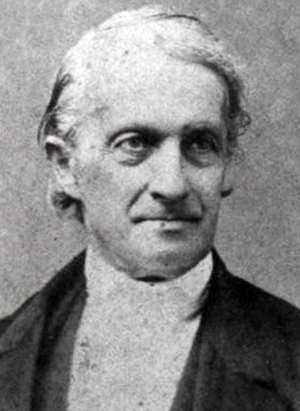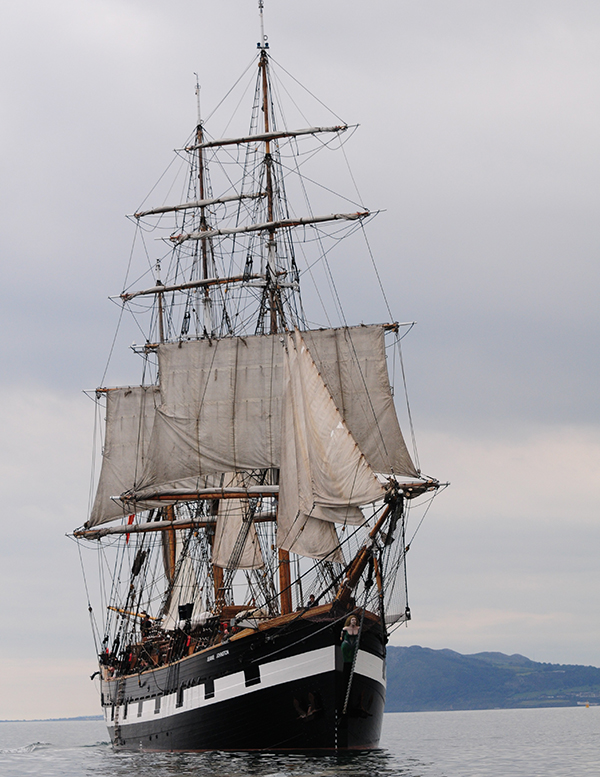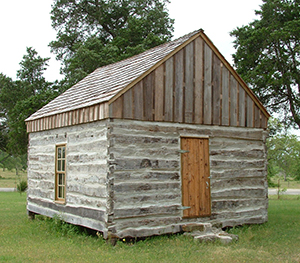Dr Richard Blennerhassett and the Wends of Texas
Published in Features, Issue 2 (March/April 2021), Volume 29By Brian MacMahon
“All available evidence suggests that he was a conscientious doctor and humanitarian who maintained high standards of care and hygiene.”

Above: The leader of the Wend migration to Texas, Revd Jan Kilian. (Wikimedia)
Serbin, a hamlet in Lee County, Texas, is the spiritual home of an ethnic minority known as the Wends. Sometimes known as Sorbs, the Wends have been described as one of the smallest ethnic groups in the USA. They are of Slavic descent, and the Texas Wends originated in Lusatia in central Europe, an area along the River Spree, near the German–Polish border. In 1854 a group of approximately 500 Wends decided to emigrate to the USA and they chose as their leader Revd Jan Kilian, a prominent academic and author.
The Wends were devout Lutherans and this mass emigration was the culmination of prolonged persecution by Prussian authorities. Earlier Wendish emigrants had sent back positive reports on Texas and the religious freedom offered in the New World. In early September 1854, the group travelled by train to Hamburg and then on to Liverpool, where they commissioned the three-masted Ben Nevis under Captain William Herron. The ship had two doctors and a crew of 42. The Wends spent four nights in lodgings in Liverpool and were ready to set sail on 17 September, when four cases of cholera broke out on the Ben Nevis, probably from contaminated water brought on board. All passengers were taken off and the ship thoroughly cleaned and fumigated. More cases followed and approximately fifteen people died. Eventually, on 26 September, after three days with no new cases of cholera, the Ben Nevis was allowed to sail. The decision proved too hasty, because cholera broke out again within hours and seven more people died as it sailed towards Queenstown (Cobh).
Dr Richard Blennerhassett
One of the doctors on the Ben Nevis was named Hanka, and he also acted as interpreter for the Wends. The other was Richard Blennerhassett of Tralee, who had previously served on the emigrant ship the Jeanie Johnston, a replica of which is now docked at Custom House Quay in Dublin. Blennerhassett came from a distinguished Kerry medical family. His father, Henry, was a doctor in Tralee, where he was known as ‘the poor man’s physician’. He published research on smallpox and tuberculosis, and the Wellcome Trust Library in London holds a copy of his 1805 dissertation, in Latin, from the prestigious medical school of Edinburgh University. Richard was the second of Henry’s seven sons and in 1843 he also qualified as a doctor in Edinburgh, where he then did surgical training, followed by a qualification in midwifery in Dublin.
Henry Blennerhassett supported Repeal, and in 1844, when Daniel O’Connell was held in Richmond jail, two of his more adventurous sons decided that they would sail a small boat, the Colleen Dhas, from Blennerville (the port of Tralee, named after the family by Sir Rowland Blennerhassett in the eighteenth century) to Dublin to visit the great man. This daring—even foolhardy—escapade took them round Kerry Head and up the Shannon estuary, through Lough Derg and eventually along the Grand Canal to Dublin. It took them a week, and on arrival they were invited to dine with O’Connell, who was comfortably lodged in the jail. When the Liberator later visited Tralee, the celebrated Colleen Dhas was carried at the head of a procession through the town.
Richard was not involved in that voyage, as he was continuing his medical training, but he shared the same adventurous spirit as his brothers. He could have made a comfortable living anywhere he chose but he decided to serve as a ship’s doctor, the least profitable and most dangerous form of medical practice. His first experience was as ship’s doctor on the Bassora Merchant, on a horrific and traumatic two-year voyage which would have made any other young man recoil from a career at sea. The ship sailed first to Calcutta, where Richard took the opportunity to study cholera. It then sailed for Demerara with 250 emigrants on board, and Blennerhassett obtained direct experience when cholera broke out on board. Almost all of the passengers were affected and 51 died of the disease. Because the sailors and passengers were afraid to handle the dead, it fell to Blennerhassett to consign each body to the deep at night-time. It was extraordinary that he ever sailed again after this harrowing experience.
All available evidence suggests that he was a conscientious doctor and humanitarian who maintained high standards of care and hygiene. He served on five outward voyages of the Jeanie Johnston from Tralee and there were no deaths while he was on board. The ship was owned by the Donovan firm in Tralee, who stated:

The replica emigrant ship the Jeanie Johnston—Richard Blennerhassett served as ship’s doctor on five outward voyages of the original vessel from 1848. (Wikimedia)
‘Previous to sailing on our ship in 1848, Dr Blennerhassett bore the reputation in his own neighbourhood of being a well-informed and clever medical man and was generally liked and respected. We believe that few British ships taking emigrants to north America were ever supplied with a more efficient or careful medical officer.’
Anxious emigrants in Tralee asked ‘Does Richard Blennerhassett sail on this ship this voyage?’ and were reassured to learn that he did.
Queenstown
The Ben Nevis sailed into Queenstown on 29 September 1854, with 21 people under treatment for cholera. There was considerable alarm in that busy port at the arrival of a cholera-infested ship, and two alert port officials—Dr Scott, medical officer, and Capt. de Courcey, emigration officer—were determined to prevent the disease from spreading ashore and causing havoc. They acted decisively to quarantine the ship and passengers. A vessel called the Elisa was fitted out as a hospital ship for those passengers already infected, while healthy passengers were transferred to the Inconstant, where ‘good diet, warmth, cleanliness and ventilation’ prevented any further cases. Twenty-nine passengers of the Ben Nevis died of cholera during the three weeks it was in Queenstown and three died of other causes, but all were contained on board ship. The Cork Examiner of 25 October gave high praise to the two officials, Capt. de Courcey for his ‘promptitude, energy and watchful superintendence’ and Dr Scott for his ‘medical skill and unwearied attention’, which ensured that ‘not a single case of cholera occurred in Queenstown, or at any other place within the harbour’.
The Ben Nevis was thoroughly fumigated and the bedding destroyed, and, after a seven-day period with no deaths, it was finally cleared for departure on 23 October. More deaths from various causes occurred on the eight-week voyage to Galveston, Texas, making a total of approximately 73 deaths since the c. 500 Wends had left home.
Death of Blennerhassett
Among those who died of cholera in Cobh was 36-year-old Richard Blennerhassett, on 30 September 1854. In Jan Kilian’s account of the journey to Texas, he wrote that he gave ‘the bounty of holy communion’ to ‘the English [sic] physician Blennerhassel’ just before he died. Richard’s father travelled to Queenstown to bury him in Old Church Cemetery. He was met by a frightened, angry group of about 50 local people who were trying to prevent the body from being brought ashore. They were afraid of infection and they did not want any more cholera burials. Richard’s burial was eventually allowed to proceed on condition that it would be the last. His grave was not marked and its exact location is still unknown. Neither is it known where other victims from the Ben Nevis were buried. In a letter to the press, Henry Blennerhassett described the circumstances of his son’s burial and stated that he fully understood the concerns of local people. He advised the authorities that future victims of cholera should be buried on an uninhabited island in the harbour. Later, when a Liverpool coroner’s report on the first deaths on the Ben Nevis questioned the competence of its two doctors, claiming that they had wrongly identified the cause of some of the deaths, Henry stoutly defended his son’s reputation in the press.

Above: Revd Jan Kilian lived in a log cabin similar to this replica from 1855 until his death in 1884. (Ernest Mettendorf)
The Wends in Texas
From Galveston the Wends trekked inland, eventually settling at Rabbs Creek. Texas had been annexed by the United States in 1845 and the pioneers were able to purchase land at $1 an acre. They faced great challenges in the early years, but they eventually built homes, a school and a church and established the town of Serbin, meaning ‘Sorbian land’ in their language. Revd Jan Kilian remained their leader and pastor until his death in 1884, when he was still living in the log cabin built for him in 1855. A building in Concordia University Texas in Austin is named Kilian Hall and the university holds the bell that the Wends brought from Lusatia in 1854.
The Wends had emigrated to preserve their religious identity but their language and traditions faded away in the melting-pot of the USA. Today, only about a hundred people live in Serbin, which is five miles from Giddings, the county seat. Its main historical features are St Paul’s Lutheran church, dating from 1871, and the nearby cemetery with a memorial to those who died on the journey to the New World. The Texas Wendish Heritage Museum is located in the former schoolhouse, and there is an annual cultural festival in September. For Americans of Wendish descent, the eventful voyage of the Ben Nevis, including the sacrifice of Dr Richard Blennerhassett, remains a significant part of their foundation story.
Bryan MacMahon’s book on the Protestant mission in Dingle and west Kerry will be published by Eastwood in 2021.
FURTHER READING
M. English & H. O’Carroll, Sailing the Irish Famine tall ship Jeanie Johnston (Cork, 2012).
R. McMorran, ‘The voyage of the Colleen Dhas’, The Kerry Magazine, No. 2 (1990).
















